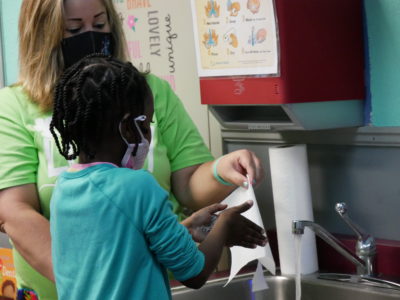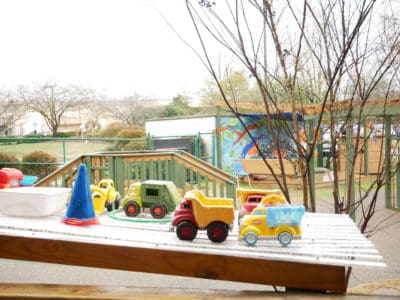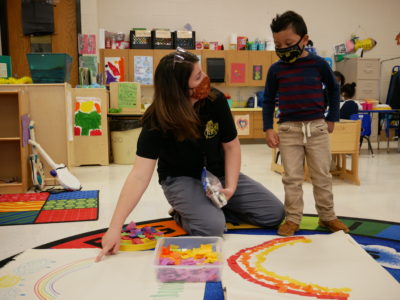

|
|
About 70% of the child care slots children filled before the pandemic are filled again, said Department of Health and Human Services (DHHS) Chief Deputy Secretary Susan Perry on Tuesday.
“We’ve been slowly inching up,” Perry said in a presentation to the bicameral early childhood legislative caucus on the early education landscape and the funds available to support it. “We haven’t seen it move a lot in the last couple of months.”
That number dipped to 20% in April 2020, Perry said, as the state sent operational grants and other supports to keep providers afloat. As parents re-enter the workforce, some parents’ jobs become more flexible, and programs struggle to find teachers, she said the early care and education system’s future is uncertain.
“Our child care system, unlike our K-12 system, is almost exclusively funded by parent fees,” Perry said. “So parent fees, when they’re not coming in, child care programs are obviously struggling to operate.”
Rep. David Willis, R-Union, is both a co-chair of the caucus and the owner and operator of Kiddie Academy, a private preschool in Charlotte. Financial support from DHHS over the last year has helped him keep the school’s doors open, he said, thanking Perry on behalf of his employees and the child care community across the state.
“Obviously, we’re not out of the woods yet,” Willis said. “As you showed, the number of students who have returned is still well below where we were. And a lot of businesses are still treading water.”
The picture looks different for children whose parents receive subsidy assistance to help cover the cost of care, Perry said. Parents must be working and fall below certain income thresholds to qualify. More than 90% of the pre-pandemic subsidy slots are now filled. The waitlist to receive subsidy assistance is now sitting at 19,000 children. The program is funded by both federal and state dollars.
“Just a couple months ago we had 16,000 children, so our waiting list is rapidly growing,” she said. “It means there are children who are eligible for subsidy, their families are working, they make low enough amounts that they’re eligible, but there are not enough dollars to fund them.”
It’s unclear how the market might shift in the years ahead, Perry said. If employers allow more remote work post-pandemic and if some parents choose to stay home instead of pay for child care, more providers will likely close.
At a time when many retail and service jobs are offering higher wages, child care providers are struggling to attract and retain teachers, she said.
Nationally, 200,000 early educators have left the workforce during the pandemic, said Lea Austin, executive director of the Center for the Study of Child Care Employment. The Center released an early educator workforce index in February, which shows 2019 median wages for child care workers in North Carolina at $10.62 (compared with $11.65 nationally), $12.83 for preschool teachers ($14.67 nationally), and $27.89 for kindergarten teachers ($32.80 nationally).
‘A very significant investment’
Perry also outlined several federal early childhood funding streams and how the department has used or plans to use them.
The American Rescue Plan, a federal law passed in March 2021, provides three main categories for early childhood investments.
The first category, which includes $805 million for the state, is for stabilization grants for child care providers. This money was already allocated by the legislature, and, Perry said, DHHS is creating an application process to begin disseminating grants.
The Office of Child Care outlines requirements for grantees and allowable uses of those funds here. All funds must be obligated by September 2022 and liquidated by September 2023.
Child care programs must follow health and safety guidelines, pay employees the same amount and provide the same benefits throughout the duration of the grant, and provide relief from co-payments and tuition for parents to the extent possible.
Providers can use the funds for:
- Personnel costs.
- Rent, utilities, facilities maintenance, and insurance.
- Pandemic-related equipment and supplies.
- Goods and services, like food, toys, learning materials, and diapers.
- Mental health services for children and employees.
“We’re in the process right now planning how to put those grants out and make it easy for all of our child care programs to have equitable access to these stabilization grants dollars,” Perry said, adding that the department will encourage providers to consider using those funds for scholarships for families who make too much to receive subsidy but who still struggle to afford care, as well as bonus payments for teachers.
The second category, which includes about $503 million for North Carolina, is meant to make child care more affordable for parents, according to a White House statement. This stream is more flexible, Perry said, and has yet to be allocated.
The Senate’s proposed budget would use those funds to reduce the subsidy waitlist, prioritizing children in foster care, continue to cover parent co-pays for the rest of this year, and award staff bonuses based on the amount of time the teacher has worked at the facility. Read more about the Senate’s proposal here.
Perry said using nonrecurring money to provide subsidy assistance could be an issue, as federal law requires the state to continue that assistance until the child is 12 or the family no longer needs it.
Find more about the department’s priorities, from workforce supports to learning loss remediation, in the article below.
The third category of early childhood ARP funds includes $16 million in recurring Child Care Development Fund money. These are funds the state receives each year, Perry said, that have been included in the ARP this year.
Perry said the department recommends the state raise the rates that providers receive to serve children on subsidy. A separate piece of legislation, filed by the House in April, would ensure providers, who currently receive different amounts of funds depending on their location, would at least receive the state average.
“It is fair to say that from a federal perspective, there is more significant investment in early childhood than there ever has been in history,” Perry said. “There are some caveats to it in terms of the fact that it is nonrecurring funding obviously, so that impacts the kinds of things that we can use the dollars for, but nevertheless, it is a very significant investment at a very important time for early childhood nationally and in our state.”






